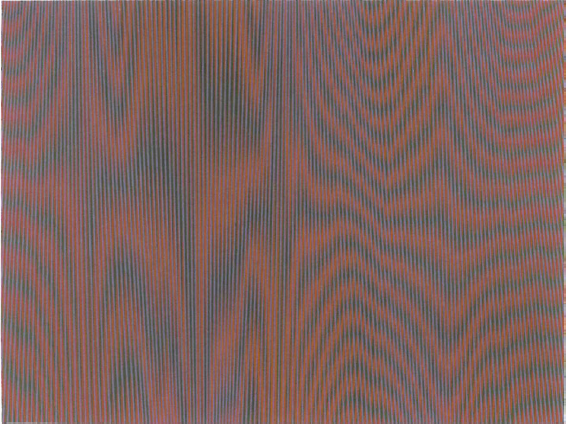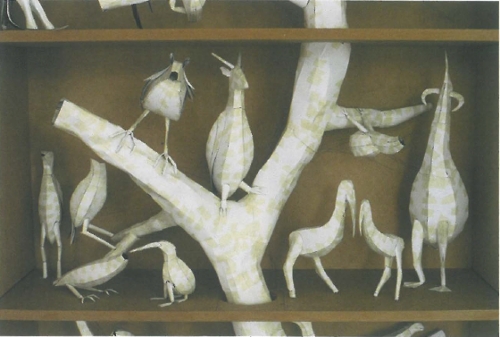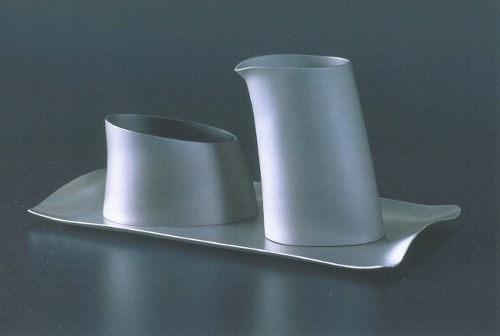
It's difficult not to regard Disorientate as a blast from the past. It only adds to the subject of disorientation to discover that these paintings were produced over a period of about thirty years, from the 70s to the present, continuing an examination of Minimalist themes and opticality. An historical disorientation produced, in no small part, by the lack of any medium other than painting. It serves as a reminder of the special place given to painting up until Modernist ideals lost their gloss.
Clearly painting still has its appeal, one that is now specifically in relation to other media rather than to itself. There still seems a need, though, to replay the schism created by Minimalism within the development of Modernist abstraction. Neil Haddon and Jon Plapp both deliberately refer to and short-circuit the self-referential integrity of the picture plane essential to the purity of the latter and to the site-specific literalness of the former. There's also a desire to incorporate a less precious, hermetic response to them, allowing for possible associations (humorous ironic ones at times) to be drawn into their work. Plapp's work, in the catalogue, is said to be '&reminiscent of interlocking rows of compacted staples&' and Haddon, in using commercial house paint, makes a conscious link to house renovating and décor. John Dunkley-Smith similarly disrupts the optical purity of his abstractions through their being inspired directly from the support structure of the Scenic Railway at Luna Park in St Kilda, Melbourne. This series of four hard-edge abstractions painted in primary colours are of an identical formal design but are confused as such, through a misleading weave of grid and colour variation. They have a child-like puzzle quality to them, '&a structure perceived as an 'intuitively' engineered construction dedicated to pleasure&'
Besides John Aslanidis's paintings looking rather like a 70s Progressive Rock record cover, the synaesthetic relationship between sound and vision is somewhat tenuous (like Kandinsky's eccentric colour theory) but hypnotic optical effects like the famous moiré phenomenon, (represented in this exhibition by Paul Boam, Wilma Tabacco and Aslanidis) have a similarly awkward relationship with painting, despite their optical alignment. Because of its unpredictable, surreal appearance the use of the moiré effect in painting is often dismissed as an optical trick not worthy of an artist's, particularly an abstract artist's, concern. Its roguish quality not only undermines the picture plane, which it seems to atomise, but it also subverts the desired objectivity commonly associated with sight; a desire for sensory perspective. Whilst titillating the optical nerves, it disarms the viewer by upsetting the articulation of difference between them and the artist, or the work, thrusting sight and by implication the visual world, back into the body as merely a solipsistic projection.
There's not a lot you can do with the moiré device. One person's moiré effect is much like another's, it being necessarily a subjective quasi-anonymous phenomenon. This being said, the attempts in this exhibition to tame it, result from differences, not of style so much but of approach to the materials used, in much the same way as a weaver chooses different threads and colours. Tabacco delights in the rawness of the effect, using a unified all-over combination of colours, whereas Boam uses a more sophisticated range of colour appearing to skirt around immanent forms.
Paul Zika's curatorial choice is divided between two forms of abstraction that claim a fusion of the object of the painting with its surroundings. One relates more to site-specific, architectonic concerns, the other to pure subjective opticality; both creating a palpable sensual environment (painting as installation?). These paintings appeal to our body's subjective sense of space and immediacy, the surfaces of which provoke a re-examination of how subjectivity is placed, as either transfixed in alienated ocularcentrism or linked to common abstract structures that function in the larger world.












